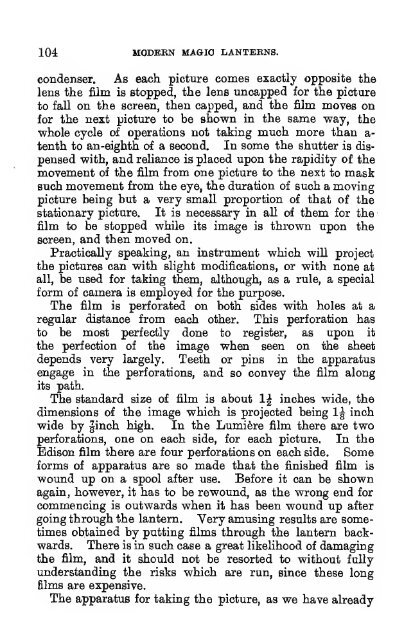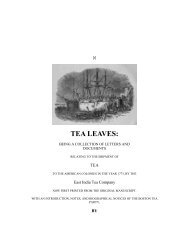104 MODBEN MAGIO LANTEBNS.condenser. As each picture comes exactly opposite <strong>the</strong>lens <strong>the</strong> film is s<strong>to</strong>pped, <strong>the</strong> lens uncapped for <strong>the</strong> picture<strong>to</strong> faU on <strong>the</strong> screen, <strong>the</strong>n capped, and <strong>the</strong> film moves onfor <strong>the</strong> next picture <strong>to</strong> be shown in <strong>the</strong> same way, <strong>the</strong>whole cycle of operations not taking much more than a-tenth <strong>to</strong> an-eighth of a second. In some <strong>the</strong> shutter is dispensedwith, and reliance is placed upon <strong>the</strong> rapidity of <strong>the</strong>movement of <strong>the</strong> film from one picture <strong>to</strong> <strong>the</strong> next <strong>to</strong> masksuch movement from <strong>the</strong> eye, <strong>the</strong> duration of such a movingpicture being but a very smaU proportion of that of <strong>the</strong>stationary picture. It is necessary in aU of <strong>the</strong>m for <strong>the</strong>film <strong>to</strong> be s<strong>to</strong>pped while its image is thrown upon <strong>the</strong>screen, and <strong>the</strong>n moved on.Practically speaking, an instrument which will project<strong>the</strong> pictures can with slight modifications, or with none atall, be used for taking <strong>the</strong>m, although, as a rule, a specialform of camera is employed for <strong>the</strong> purpose.The film is perforated on both sides with holes at aregular distance from each o<strong>the</strong>r. This perforation has<strong>to</strong> be most perfectly done <strong>to</strong> register, as upon it<strong>the</strong> perfection of <strong>the</strong> image when seen on <strong>the</strong> sheetdepends very largely. Teeth or pins in <strong>the</strong> apparatusengage in <strong>the</strong> perforations, and so convey <strong>the</strong> film alongits path.The standard size of film is about Ig inches wide, <strong>the</strong>dimensions of <strong>the</strong> image which is projected being 1| inchwide by ginch high. In <strong>the</strong> Lumi6re film <strong>the</strong>re are twoperforations, one on each side, for each picture. In <strong>the</strong>Edison film <strong>the</strong>re are four perforations on each side. Someforms of apparatus are so made that <strong>the</strong> finished film iswound up on a spool after use. Before it can be shownagain, however, it has <strong>to</strong> be rewound, as <strong>the</strong> wrong end forcommencing is outwards when it has been wound up aftergoing through <strong>the</strong> lantern. Very amusing results are sometimesobtained by putting films through <strong>the</strong> lantern backwards.There is in such case a great likelihood of damaging<strong>the</strong> film, and it should not be resorted <strong>to</strong> without fullyunderstanding <strong>the</strong> risks which are run, since <strong>the</strong>se longfilms are expensive.The apparatus for taking <strong>the</strong> picture, as we have already
ANIMATED LANTEBN PIOTUEES. 105pointed out, is very similar <strong>to</strong> that employed for projecting<strong>the</strong>tn. The spool of film is run through <strong>the</strong> camera, s<strong>to</strong>pped,aji exposure made, and it is <strong>the</strong>n passed on until <strong>the</strong> wholelength, or such part of it as may be required, is exposed.Development is effected by winding <strong>the</strong> film on a drumor spool, so that <strong>the</strong> sensitive surface is entirely exposed,and immersing this in a trough of developer, of water, or of<strong>the</strong> fixing solution. Printing may be carried out ei<strong>the</strong>r hjmeans of a special apparatus, or, as is <strong>the</strong> case with <strong>the</strong>Lumiere Cinema<strong>to</strong>graph, by <strong>the</strong> actual projecting andexposiug arrangement. In <strong>the</strong> latter <strong>the</strong> negative is againwound through <strong>the</strong> machine, but this time a length of filmcoated with a lantern slide emulsion is in contact with it.The lens of <strong>the</strong> instrument is removed, and at a suitabledistance in front of <strong>the</strong> negative film a light is placed.The two fihns, <strong>the</strong> negative and <strong>the</strong> undeveloped transparency,are run in<strong>to</strong> separate receptacles. The latter isdeveloped, fixed, and washed in <strong>the</strong> ordinary way, and is<strong>the</strong>n ready for projection.Little need be said as <strong>to</strong> <strong>the</strong> precautions <strong>to</strong> be observed,and <strong>the</strong> routine <strong>to</strong> be followed ia working <strong>the</strong> animatedpictures in <strong>the</strong> lantern, since most of <strong>the</strong> informationalready given as regards <strong>lanterns</strong> generally applies equally<strong>to</strong> <strong>the</strong>se. In selecting an iastrument attention should begiven not only <strong>to</strong> <strong>the</strong> smoothness and freedom from vibrationand movement on <strong>the</strong> screen with which it works, butalso <strong>to</strong> <strong>the</strong> treatment <strong>the</strong> film itself undergoes in passingthrough <strong>the</strong> instrument. Fihns cost money, as we havesaid before, and in some of <strong>the</strong> machines we have seen, <strong>the</strong>films have got sadly scratched and knocked about with onlya few exhibitions. In examining an apparatus with a view<strong>to</strong> seeing whe<strong>the</strong>r it works without vibra.ti^n, a film shouldbe employed which is known <strong>to</strong> be free from this defect itself.If <strong>the</strong> camera has trembled during exposure <strong>the</strong> filmwiU register this movement, and <strong>the</strong>re is a likelihood thatwhen <strong>the</strong> picture is seen on <strong>the</strong> screen <strong>the</strong> specta<strong>to</strong>r mightimagine <strong>the</strong> vibration, really due <strong>to</strong> camera movement in<strong>the</strong> first place, <strong>to</strong> be due <strong>to</strong> imperfections in <strong>the</strong> projectingapparatus which it does not possess.The most unpleasant feature about a display of animated
- Page 1 and 2:
In^ f-e'
- Page 3 and 4:
Cornell UniversityLibraryThe origin
- Page 5 and 6:
HUbrniiiS'OXYGENSiMPIiEXCERTAIN ACT
- Page 7 and 8:
HUGHES' SPECIAL BIDNIALWith Solid B
- Page 9 and 10:
HUGHES' PATENT BIJOUENLARGINGLANTER
- Page 11 and 12:
MODERN MAGIC LANTERNS.
- Page 13 and 14:
:MODERNMAGIC LANTERNSA GUIDE TOTHE
- Page 15 and 16:
Preface to the First Edition.Some f
- Page 17 and 18:
CONTENTS.Chap.I. InteodttctokyII. O
- Page 19 and 20:
Modern Magic Lanterns.CHAPTER I.3nt
- Page 21 and 22:
INTEODUOTOET.ifeet in diameter, a m
- Page 23 and 24:
CHAPTERII.Nearly all the old-fashio
- Page 25 and 26:
OIL LAMPS.the other end, which went
- Page 27 and 28:
OIL LAMPS.aThey should be trimmed e
- Page 29 and 30:
CHAPTER III.^beXimeligbt.The most p
- Page 31 and 32:
THE LIMELIGHT. 13be incapable of be
- Page 33 and 34:
THE LIMELIGHT. 15in a moment on loo
- Page 35 and 36:
THE LIMELIGHT. 17is not used to the
- Page 37 and 38:
HOME-MADE OXYGEN, GAS HOLDBES, ETC.
- Page 39 and 40:
HOME-MADE OXYGEN, GAS HOLDEES, ETC.
- Page 41 and 42:
—BOME-MADB OXYQEN, QAfi HOLDBBS,
- Page 43 and 44:
CHAPTER V.Compteeaeb(Baeee.Most lan
- Page 45 and 46:
OOMPEESSED GASES. 27with the pressu
- Page 47 and 48:
COMFBESSED GASES. 29are atmospheres
- Page 49 and 50:
COMPKESSED GASES. 31for tttmmg on a
- Page 51 and 52:
—OOMFBESSED QASEB. 33foot, red or
- Page 53 and 54:
CHAPTEE VI.jetber, 3ncant)escent (5
- Page 55 and 56:
ETHEE, INCANDESCENT GAS, ACETYLENE,
- Page 57 and 58:
ETHEB, INOANDSSCEMT QAB, AOEXYLENE,
- Page 59 and 60:
JETS. 41inch above the top of the w
- Page 61 and 62:
JETS. 43As the jet plays upon the l
- Page 63 and 64:
JETS. 45unless the pressure is grea
- Page 65 and 66:
THE ELEOTBIO LIGHT. 47"Where a very
- Page 67 and 68:
THE EIiEOTEIO LIGHT. ^9Borland, of
- Page 69 and 70:
THE ELBOTEIO LIGHT. 61solid. In get
- Page 71 and 72: CHAPTER IX.^be XanternBo^i^.The var
- Page 73 and 74: THE LANTBEN BODY. ,55above the othe
- Page 75 and 76: THE LANTEEN BODY. 57mounted slide i
- Page 77 and 78: yhavingTHE LANTEEN BODY. 59by which
- Page 79 and 80: THE IiANTEEN BODT. 61Eoss' new Lime
- Page 81 and 82: THE OPTIOAIi SYSTEM. 63enclosed by
- Page 83 and 84: THE OPTICAL SYSTEM. 65a 4| inch wil
- Page 85 and 86: THE OPTICAL SYSTEM. 67Perhaps the m
- Page 87 and 88: ;CHAPTER XI.^be Screen anb (Beneral
- Page 89 and 90: THE SOEEEN AND OENEBAIi AERAKQEMENT
- Page 91 and 92: THE SCBEEN AND 6ENEBAL ABBANGEMENTS
- Page 93 and 94: CHAPTERXll.Zbe flDanipuIation of tb
- Page 95 and 96: THE MANIPULATION OF THE LANTEEN. 77
- Page 97 and 98: —THE MANIPULATION OP THE LANTEEN.
- Page 99 and 100: MOVING SLIDES AND EFFECTS. 81The pa
- Page 101 and 102: MOVING SLIDES AND EFFECTS. 83marked
- Page 103 and 104: CHAPTER XIV.Xantern fiyperimente.Th
- Page 105 and 106: LANTEBN EXPEBIMEMTS.plate. "When de
- Page 107 and 108: LANTERN EXPEBIMENT8. 89Zentmayer's.
- Page 109 and 110: LANTEBN EXPEEIMENTS. 91reflector, o
- Page 111 and 112: CHAPTEE XV.^be Xantcrn*»Spectrosco
- Page 113 and 114: THE LANTEBN-SPEOTEOBOOPE, -POLABISC
- Page 115 and 116: THE IiANTBBN-SPEOTBOSCOPB, -POIiABI
- Page 117 and 118: THE IiANTEEN-MICEOSOOPE. 99one lant
- Page 119 and 120: THE LANTBEN-MICEOSCOPS, 101jet to b
- Page 121: ANIMATED LANTEBN PIOTUEES. 103revol
- Page 125 and 126: [antern * =Highest Quality only.[en
- Page 127 and 128: INDEX.C.Abaorption, to show, 94Acet
- Page 129 and 130: iINDEX. 109Lantern, epectrosoope, 9
- Page 131 and 132: INDEXTo the Practical HandbooksPubl
- Page 133 and 134: and—';Catalogue .,PracticalPublis
- Page 135 and 136: Chas. Sceibneb's Sons, New Ywh.Bunk
- Page 137 and 138: 'ofCage;Chas. Scbibnee'b Sons, New
- Page 139 and 140: Chas. Scbibnek's Sons, New YorTc. 9
- Page 141 and 142: 'Ohas. Sceibnee's Sons, New Yorle.
- Page 143 and 144: :Ohas. Sceibneb's Sons, New Yorh. 1
- Page 145 and 146: Chas. Scbibnee's Sons, New York. 15





